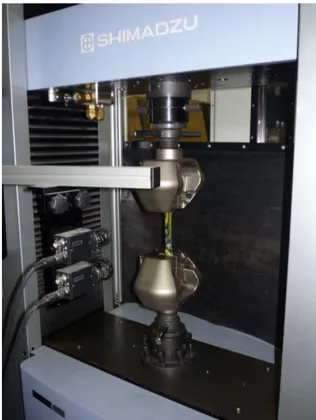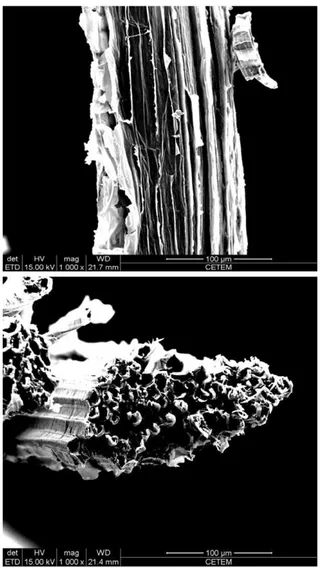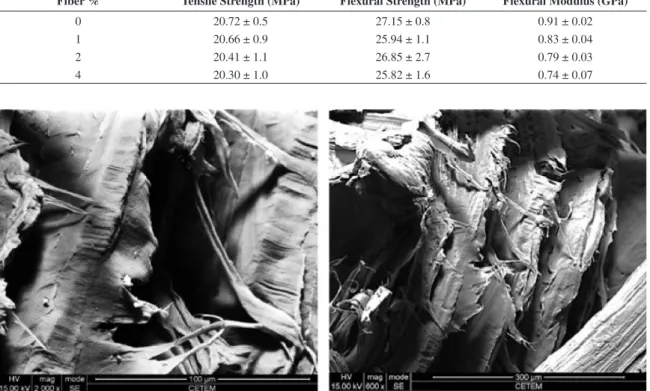e-mail: jreis@mec.uff.br
Mechanical Characterization of Sisal Fiber-Reinforced Recycled HDPE Composites
R. Chianelli-Juniora, J.M.L. Reisb*, J.L. Cardosoa, P.F. Castroa
aCivil Engineering Post Graduate Program – POSCIVIL, Universidade Federal Fluminense – UFF, Rua Passo da Pátria, 156, CEP 24210-240, Niteroi, RJ, Brazil
bTheoretical and Applied Mechanics Laboratory – LMTA, Mechanical Engineering Post Graduate Program – PGMEC, Universidade Federal Fluminense – UFF, Rua Passo da Pátria, 156,
CEP 24210-240, Niteroi, RJ, Brazil
Received: December 6, 2012; Revised: June 16, 2013
The increasing awareness of the environment protection has contributed to concerns regarding alternative procedures for recycling of plastic wastes. Since chemical processes are high cost, energy and often environment harmful, thermo-mechanical techniques of recycling rises as a good alternative. This research deals with mechanical characterization of thermo-mechanical recycling of composites based on recycled high density polyethylene (HDPE) from post-consumed motor-oil plastic containers
as matrix and natural ibers (sisal) as reinforcement. The composites were made by extrusion and then melt blended in a compression mold. The sisal ibers do not contribute to increase tensile strength. As iber content increases loss of ductility is observed.
Keywords: recycling, thermoplastics, composites, mechanical properties
1. Introduction
The environmental problem nowadays is a factor of extreme importance in the industrial world, particularly in the case of plastic processing companies, as efforts are mainly focused on the reduction and recycling of wastes generated during transformation processes and also after product end use. Plastics have become one of the materials with the greatest growth in terms of consumption and in the amount of generated wastes1.
Although the recycling capacity for plastics has been
progressively increased, the fraction of plastics that end up
in a landill is still very signiicant. The European Union (EU) produced 82.8Mt of packing waste and 48.1Mt were
recycled2. In the United States (US), the total of plastic waste
produced in 2008 were 30Mt and only 7.1% were recycled3.
In Brazil, 150kt of waste HDPE are produced per year and only 72t were recycled4. Due to that fact, researchers over
the last years have focused their studies in inding ways to
reprocess that waste plastics as new products5-10.
High-density polyethylene (HDPE) is one of the most widely used polymers, having a broad amount of applications such as bottles, containers and consumer goods. Since post-consumer HDPE from bottles cannot be used again and has high melting viscosity, HDPE becomes an interesting source of recycled material. Recycled HDPE can be used in a growing number of potential applications, such as boxes or pallets, whenever the thermal, mechanical and impact properties of the recycled polymer are close to the ones of the virgin material.
Also, iber-reinforced thermoplastic composites have
emerged as a major class of structural materials, which are characterized by easy processibility, good dimensional
stability, and excellent mechanical performance. The use of
natural ibers as reinforcement in polymers is a way to also recycle these ibers and produce high strength materials. Amongst the advantages of these ibers are: renewable,
non-abrasive, cheaper, abundance and show less concern with health and safety during handling and processing.
The mechanical properties of fiber-reinforced composites strongly depend on several factors concerning
the ibers, such as size, orientation, dispersion and
iber-matrix interfacial bonding11-13.
The aim of this work is to investigate the mechanical
properties of recycling HDPE from post-consumed
motor-oil plastic containers reinforced with sisal ibers. The HDPE/
sisal composite were mixed by extrusion and compression
molded. Tensile, lexural and thermal tests, TGA and DSC,
were performed to evaluate the mechanical properties.
2. Material and Methods
2.1.
Material
Recycled HDPE from post-consumed motor-oil plastic
containers were obtained from SEPAN Services (Niterói,
RJ, BR). The containers were drained to eliminate any oil residue and then washed with biodegradable soap. The
containers were dried at 90°C for 3 hours and then shredded
into pellets.
Continuous sisal ibers are from the state of Bahia – Brazil and obtained in local stores in matted form. The sisal ibers
are extracted from the plant leaf which is a functionally graded composite structure reinforced by three types of
ibers are located in the periphery of the leaf providing
resistance to tensile loads.
Sisal ibers were washed, cut to 30 mm in length and then oven-dried at 90°C for 24 h. All composites were made with 1%, 2% and 4% in weight of sisal ibers. The sisal ibers were mixed with the polymeric matrix (HDPE)
in an extruder screw (Forin, SP, Brazil) with a L:D ratio
of 24:1. Respective temperatures for the three different
processing zones from the hopper to horizontal die of the
extruder were set as 170/180/190°C and the screw speed
rate was maintained constant at 50 rpm. The extruded materials were placed in a molding set at a compression
hot press Marconi MA098/A at 170°C for 5 minutes. The pressure for heating was controlled at 4t and the cooling
pressure was 0.5t. Figure 1 displays the tensile specimens manufacturing process.
2.2.
Methods
Recycled HDPE thermal behavior was measured
with a differential scanning calorimetry, DSC-50H
Shimadzu, under nitrogen atmosphere. DSC samples were heated at a rate of 30°C/min from 10 to 500°C. The Thermogravimetry (TGA) analysis was performed in the
Shimadzu DTG - 60H, the temperature range from ambient (26°C ± 2) to 500°C, with heating rate of 5°C / min. The test was carried out under nitrogen atmosphere at a low of 50 ml/min.
Sisal ibers were silver covered in an argon vacuum
apparatus (Bal-Tec SDC 005) for 250 s and then analyzed in a FEI/QUANTA 400 scanning electron microscope (SEM).
Mechanical tests were carried out in an universal-testing machine AG-X 100 Shimadzu
equipped with video type
Non-Contact Extensometer elongation measurement. For tensile tests, the ASTM D638[15] standard was followed. The
test speed used was 5 mm/min and the distance between
grips was 115 mm for specimens type O. The three-point
bending tests were performed according to ASTM D790[16]
at a cross-head displacement of 2 mm/min with a support span of 80 mm. Non-contact elongation measurements were performed using CCD cameras to capture digital images
of test specimens, see Figure 2. Finally, image processing of the data is carried out on a computer and calculated the elongation of the gauge length.
3. Results and Discussion
Figure 3 presents the DSC analysis of recycled HDPE.
From Figure 3 it can be seen that recycled HDPE
has a melting temperature (TM) of 133°C. For common
commercial grades of medium and high-density polyethylene
the melting point is typically in the range 120 to 130°C[17].
The glass transition temperature (Tg) estimates the maximum operating temperature of the composite. On the thermogravimetry analysis is observed the thermal degradation of the composite.
Figure 4 presents the Thermogravimetry (TGA) measurement of recycled HDPE and sisal ibers.
For recycled HDPE, degradation occurred at 430°C, however, at 200°C a slight mass decrease can be observed.
This can be explained by the decomposition of the residual oil from the containers.
For sisal ibers, it can be seen that the degradation temperature is 300°C, higher than the 133°C of recycled HDPE TM temperature. Therefore, a composite sisal/HDPE
can be processed with no harm to the raw materials.
Sisal ibers microscopies are shown in Figure 5.
The tensile test results from all formulations are presented in Table 1.
Analyzing Table 1 it is clear that sisal ibers has no signiicant effect in the maximum tensile strength, the standard deviation is less than 3%. Compared to virgin
HDPE, the tensile strength of unreinforced recycled HDPE is similar to the values found in the literature8. Similar to
tensile behavior, the sisal/HDPE lexural strength decreases as sisal ibers are added to the matrix. Incorporating 1% of
Figure 3. Differential Scanning Calorimetry (DSC) analysis of
recycled HDPE.
Figure 4. Sisal Fibers and Recycled HDPE TGA test result in
nitrogen atmosphere.
Figure 6. Tensile stress-strain average curves of HDPE/Sisal composites with different iber percentages.
Figure 5. Sisal iber morphology.
sisal ibers diminish the lexural strength in 4.4%. A lower decrease, 1.1%, is observed when 2% of sisal ibers are used. Increasing sisal ibers content to 4%, the lowest value is calculated, 25.82 MPa, representing a 4.9% decrease. Taking the standard deviation into account, the decrease in the lexural strength of HDPE matrix is not signiicant. The incorporation of sisal ibers also diminish lexural modulus
of elasticity, but again analyzing considering the standard deviation.
Typical tensile stress-strain curves obtained for different
sisal ibers content in recycled HDPE matrix are presented
in Figure 6.
According to Figure 6 it can be observed that increasing sisal fibers content a loss of ductility in sisal/HDPE composites is reported, but no signiicant change in the tensile modulus of elasticity is observed. Adding sisal ibers to recycled HDPE matrix contribute to a decrease in the strain. This may be due to a poor fiber/matrix interfacial adhesion, since sisal ibers were used untreated, i.e. with no surface treatment of ibers to improve adhesive bonding. Also, since the recycled HDPE is obtained from
oil containers, some residue can contribute to the loss
of ductility. Figure 7 presents the SEM images of the composites containing 4% of sisal ibers.
observed. This poor adhesion can also be explained due to the hydrophilic nature of cellulose and the hydrophobic property of HDPE.
Figure 8 displays the typical curves of lexural strength vs. strain for different sisal iber content in recycled HDPE
matrix.
In lexion, a different post-peak behavior is observed when sisal ibers are added to recycled HDPE matrix. A loss in the maximum lexural strength is observed and 4% of sisal ibers content provide the higher decrease. The lexural ductility of sisal/HDPE composites are similar
to unreinforced recycled HDPE until tests were carried.
According to ASTM D790-07[15], the test should be terminated when the maximum strain in the outer surface
of the test specimen reaches 0.05 mm/mm or at break, if break occurs prior to reaching the maximum strain. Since the maximum strain was reached for all sisal/HDPE at approximately 0.08 mm/mm tests were carried out until 0.1 mm/mm in order to obtain post-peak behavior and measure maximum lexural strength. No signiicant change in the lexural modulus of elasticity was observed.
Tensile and lexural behavior of pure HDPE reinforced with sisal ibers is the opposite from recycled HDPE from oil containers reinforced with sisal ibers[5,13]. Comparing results, unreinforced HDPE results are slight higher than recycled HDPE. This was expected since the process of heat
and cooling degrades thermoplastic materials. Untreated and treated sisal ibers contribute to increase both tensile and lexural properties of virgin HDPE. Recycled HDPE must be
completely clean from any substance that can contaminate the post consumer process. On this case the remaining oil, even the one that it cannot be seen, contributes to inhibit a
good iber/matrix surface adhesion.
4. Conclusions
The present work showed the usefulness of sisal iber
as reinforcement to recycled high density polyethylene (HDPE) matrix.
The tensile and lexural properties of sisal/recycled HDPE remain the same with no signiicant detriment to ultimate strength. The interface between sisal ibers and
the HDPE matrix is poor due to the hydrophilic nature of cellulose and the hydrophobic property of HDPE. This
decrease can be attributed to no iber surface treatment or oil
residue in the matrix. The composites become less ductile
Table 1. Tensile strength of all Sisal/HDPE formulations.
Fiber % Tensile Strength (MPa) Flexural Strength (MPa) Flexural Modulus (GPa)
0 20.72 ± 0.5 27.15 ± 0.8 0.91 ± 0.02
1 20.66 ± 0.9 25.94 ± 1.1 0.83 ± 0.04
2 20.41 ± 1.1 26.85 ± 2.7 0.79 ± 0.03
4 20.30 ± 1.0 25.82 ± 1.6 0.74 ± 0.07
Figure 8. Flexural stress-strain average curves of HDPE/Sisal composites with different iber percentages.
as sisal iber content is increased in tension. The modulus of elasticity is unaltered for all sisal ibers percentages. Further work must be done related to iber surface treatment
and residue elimination in recycled HDPE to improve mechanical properties.
Acknowledgements
The inancial support of FAPERJ (Rio de Janeiro State Funding) and CNPq (Research and Teaching National Council) are gratefully acknowledged.
References
1. Sanchez-Soto M, Rossa A, Sanchez AJ and Gamez-Perez J. Blends of HDPE wastes: Study of the properties. Waste Management. 2008;28:2565-2573. PMid:18093819. http:// dx.doi.org/10.1016/j.wasman.2007.10.010
2. European Environmental Agency. T h e E u ro p e a n environment - State and outlook. Copenhagen: European Environment Agency; 2008.
3. Environmental Protection Agency. Municipal Solid Waste in the United States: 2008 Facts and Figures, Washington: European Environment Agency; 2008.
4. Plastivida Instituto Sócio-Ambiental dos Plásticos. Monitoramento dos indices de reciclagem mecânica dos plásticos. São Paulo; 2007. (In Portuguese).
5. Choudhury A. Isothermal crystallization and mechanical
behavior of ionomer treated sisal/HDPE composites. Materials Science & Engineering A. 2008;491:492:500.
6. Sae-Oui P, Sirisinha C, Sanguanthammarong P and Thaptong
P. Properties and recyclability of thermoplastic elastomer
prepared from natural rubber powder (NRP) and high density
polyethylene (HDPE). Polymer Testing. 2010;29:346-351. http://dx.doi.org/10.1016/j.polymertesting.2009.12.010 7. Yemele MCN, Kouba A, Cloutier A, Soulounganga P and
Wolcott M. Effect of bark fiber content and size on the mechanical properties of bark/HDPE composites. Composites part: A. 2010;41:131-137. http://dx.doi.org/10.1016/j.
compositesa.2009.06.005
8. Adhikary KB, Pang S and Staiger MP. Dimensional stability
and mechanical behaviour of wood-plastic composites based on recycled and virgin high-density polyethylene (HDPE). Composites part: B. 2008;39:807-815. http://dx.doi. org/10.1016/j.compositesb.2007.10.005
9. Lei Y, Wu Q, Yao F and Xu Y. Preparation and properties
of recycled HDPE/natural fiber composites. Composites
part: A. 2007;38:1664-1674. http://dx.doi.org/10.1016/j. compositesa.2007.02.001
10. Avila AF and Duarte MV. A mechanical analysis on
recycled PET/HDPE composites. Polymer Degradation and Stability. 2003;80:373-382.
http://dx.doi.org/10.1016/S0141-3910(03)00025-9
11. Kim JT and Netravali AN. Mercerization of sisal ibers: Effect o
tension on mechanical properties of sisal iber and iber-reinforced
composites. Composites part: A. 2010;41(9):1245-125. http:// dx.doi.org/10.1016/j.compositesa.2010.05.007
12. Murali Mohan Rao K, Mohana Rao K and Ratna Prasad AV. Fabrication and testing of natural ibre composites: Vakka, sisal,
bamboo and banana. Materials and Design. 2010;31(1):508-513. http://dx.doi.org/10.1016/j.matdes.2009.06.023
13. Noorunnisa Khanam P, Abdul Khalil HPS, Ramachandra Reddy G and Venkata Naidu S. Tensile, Flexural and Chemical
Resistance Properties of Sisal Fibre Reinforced Polymer Effect of Fibre Surface Treatment. Journal of Polymers and the Environment. 2011;19(1):115-119. http://dx.doi.org/10.1007/ s10924-010-0219-7
14. Li Y, Mai Y-W and Ye L. Sisal Fibre and its composites: a
review of recent developments. Composites Science and Technology. 2000;60:2037-2055. http://dx.doi.org/10.1016/ S0266-3538(00)00101-9
15. American Society for Testing and Materials – ASTM. D638-08: Standard Test Method for Tensile Properties of Plastics. ASTM; 2008.
16. American Society for Testing and Materials – ASTM. D790-07:
Standard Test Methods for Flexural Properties of Unreinforced and Reinforced Plastics and Electrical Insulating Materials. ASTM; 2007.
17. Peacock AJ. Handbook of Polyethylene: Structures: Properties,


